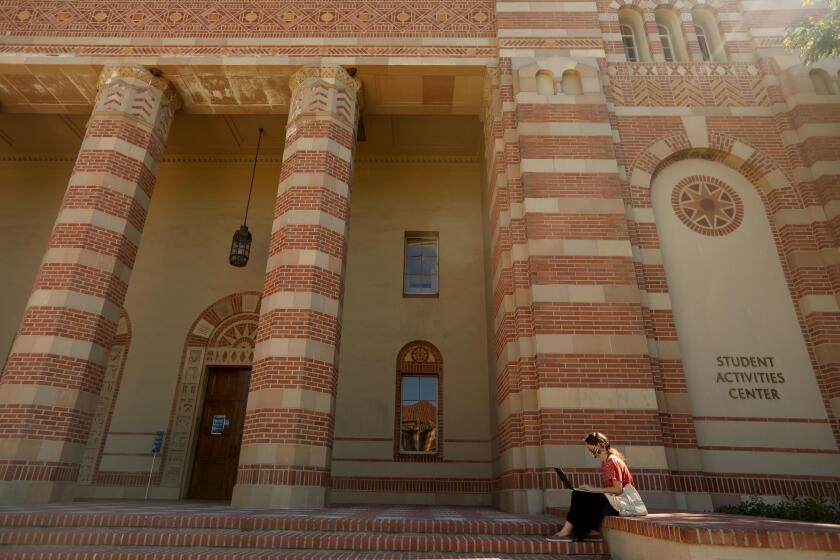Should California bite the bullet on high-speed rail?
- Share via
If and when California’s high-speed train is built, how fast would it have to go, and how much cheaper would a ticket have to cost, for you to give up flying?
I went to Union Station this week, as well as the Burbank airport, to ask travelers those very questions. And I’d like to hear from you too.
DISCUSS: California’s high-speed rail
But let me set things up first.
Every time I consider booking a flight from Burbank to Oakland, I think about whether I’d prefer to drive instead. Usually, I go with the one-hour flight, and if there are no delays, I’m always grateful I didn’t make the six-hour drive up Interstate 5. But if traffic to the airport is rough, security is a headache and the flight is delayed, I sometimes end up wishing I’d driven.
How nice it would be to have a third option.
In 2008, California voters supported — bravely, naively or perhaps both — construction of a gargantuan, 520-mile bullet train route and authorized $9 billion in state bonds to get things going. The total projected cost to lay rail for electric cars, whizzing from San Diego to San Francisco at almost 200 mph, was originally estimated at $33 billion.
Since then, the high-speed dream has become a slow-motion nightmare, and we might be better off running a zip line from Mt. Shasta to Mt. Baldy.
The projected completion date has gone from 2020 to 2033. The anticipated cost has ballooned to as high as $117 billion, and no one seems to have a clue where the bulk of the money would come from. The state auditor and the state Legislative Analyst’s Office have raised serious concerns, and the rail authority’s own peer review group said the project represents “an immense financial risk” to the state. And two weeks ago, the railroad authority’s top executive resigned.
To top it off, a poll last fall said nearly two-thirds of registered voters would run this train off the rails if they had a chance to vote again.
But when I spoke to rail passengers at Union Station on Monday night, and to air travelers at Burbank on Tuesday morning, I got roughly the same amount of support for high-speed rail as I did criticism of the project. This mirrored my own thinking. I like the concept. I just don’t know if it’s a realistic or even sane idea at the moment, despite Gov. Jerry Brown’s recent cheerleading efforts.
“That much money is obscene,” said Kevin Lundby, a human resources manager who was waiting for a train to get him home to Santa Clarita.
But “if it can support itself” (that’s a very big if), and “if it creates jobs” (which it certainly will, despite disagreements over how many), he’d be willing to at least try taking the train.
Like many people I spoke to, Lundby was surprised by the projected cost of a train ticket from Los Angeles to San Francisco. The authority is estimating that a ride on the bullet will cost 83% of what a plane ticket from L.A. to San Francisco will cost, and that the trip would take almost exactly two hours and 40 minutes.
If, say, a train ticket costs only $83 as opposed to $100, but it’ll take you longer to get there, are you going to jump at that deal?
I have my doubts.
“Time, value, money,” said architect Tom Heffernan, who was boarding a train to San Diego, but said he wouldn’t stop flying to Northern California for such a small price break.
But Van Nuys minister Anona Fleming, who has a fear of falling from the sky, was ready to sign up for a high-speed rail pass. And Devin Grant, who described himself as a semi-pro soccer player, actor, model and musician — let me be the first to nominate him for L.A.’s poster child — said he thinks an electric train will spur economic growth up the spine of the state and be kind to the environment, so he’s in.
Not Joe Bogenschutz, though. As the Burbank resident was about to board a plane Tuesday morning in Burbank, he said: “If they’re saying $100 billion, that means it’ll be $200 billion.”
He could be right. The way costs keep rising, we could end up with a $100-billion train from Bakersfield to Fresno. And even if the whole thing gets built, there’s the question of whether regional transportation in Southern California and the Bay Area would be adequate to get people to the high-speed stations.
Mary Lou Parks, a semi-retired nurse from Lompoc, told me she has doubts about funding, and the high-speed line won’t be of much use to her because she lives near the central coast. But she likes the big idea that a bullet train represents and how it positions California in the world order. She wonders if, in 20 years, we’d regret having let the whole thing fall apart.
Parks, who was on her way to her best friend’s funeral in Omaha, said she thinks our gluttonous oil dependence should be a strong consideration. There’s been much difference of opinion as to how environmentally friendly high-speed electric rail will be versus air travel or auto travel — all vehicles might be electric in 20 years — but Parks’ point goes beyond that. She’s concerned about diminishing supplies of fossil fuel, and the many costs of going after it.
“Someday, we’re going to have to face this,” she said.
And of course, the state could use the thousands of jobs that would be created. But how do we know this wouldn’t be the biggest boondoggle in state history?
Your thoughts? Email me or join the conversation.
More to Read
Sign up for Essential California
The most important California stories and recommendations in your inbox every morning.
You may occasionally receive promotional content from the Los Angeles Times.











